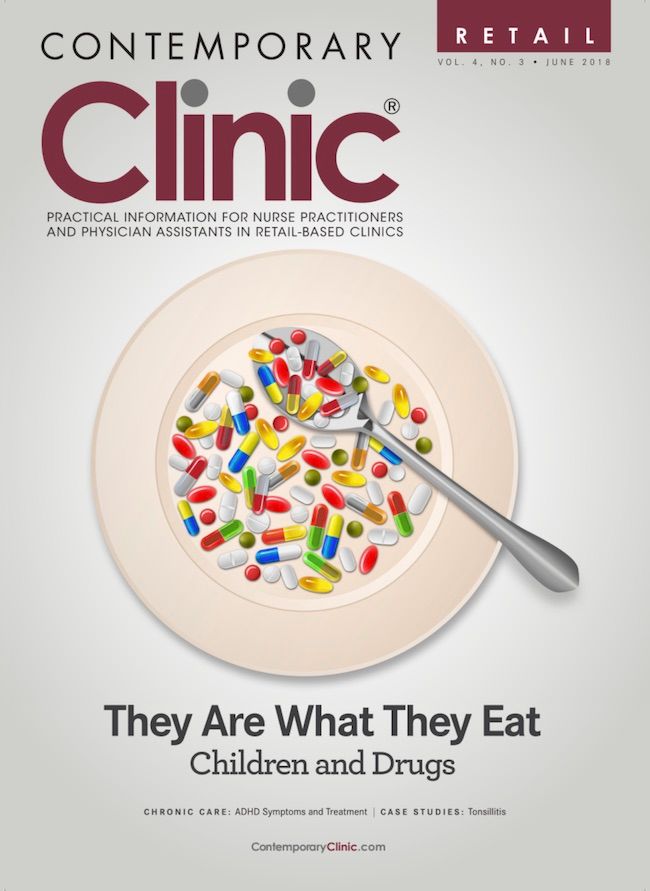Tonsillitis
Sore throat, strep throat, and tonsillitis are often used interchangeably when presenting to a clinic, though they are not the same thing.
Sore throat, strep throat, and tonsillitis are often used interchangeably when presenting to a clinic, though they are not the same thing.1Tonsillitis refers to inflammation of the palatine tonsils, pink masses of lymphatic tissue located on the left and right sides of the back of the throat. Tonsillitis can be caused by an infection and produce symptoms such as dysphagia, fever, foul breath, odynophagia, red tonsils, a sore throat, swollen limbs, tender lymph nodes, and a white or yellow coating over the tonsils.1,2Strep throat can be an underlying cause of tonsillitis that warrants the use of antibiotics.3
CASE STUDY
A 7-year-old girl presents to the clinic with a sudden onset of fever, odynophagia, and a sore throat. Her mother reports that her daughter had abdominal pain, was febrile at 101.8°F, and vomited once the day before. The girl attends school, and plays softball twice a week. A physical examination shows that she has tender anterior cervical lymph nodes and exudate. The abdomen is nontender and soft, with no distention or masses noted. Her blood pressure is 100/60 mm Hg, her heart rate is 96, her pulse oximetry is 99% on room air, her respiratory rate is 20, and her temperature is 99.8°F.
DISCUSSION QUESTION:What additional questions would you like to ask the mother?
ANSWER:Reviewing systemic complaints in the child can aid in the diagnosis. These may include body aches, cough, eye redness or irritation, hoarseness, and a runny nose. A cough, hoarseness, and a runny nose are usually not suggestive of a bacterial infection associated with tonsillitis.4Review the immunization status of the child, finding out whether the diphtheria, tetanus, and pertussis and Haemophilus influenzae type b vaccines are up-to-date.
Pediatric diphtheria is caused by Corynebacterium diphtheriae. Symptoms include a sore throat without the presence of dysphagia, a headache, malaise, and a temperature greater than 102°F.5Ask whether family or friends recently had symptoms. Symptoms of drooling; restlessness; and an inability to lie down, swallow, talk, or walk warrant an immediate referral to an emergency department for evaluation.3,4Other red flags include difficulty opening the mouth, foul breath, and a hot potato voice.6Because tonsillitis can cause a child to not drink as much, ask the mother about signs of dehydration, including cracked lips, dark-colored urine, dizziness, dry mouth, irritability, lack of tears, low-volume urine during emptying, no urine production in 8 hours, and not drinking at all for more than 8 hours.
Regarding abdominal pain, some children older than 2 years may present with systemic complaintsof group A β-hemolytic streptococcal infection (GABHS).3Ask the mother whether the child has been confused or has had decreased alertness, neck pain, or sensitivity to light.
DISCUSSION QUESTION:What other parts of the physical exam would you include when evaluating the child?
ANSWER:A full head, eyes, nose, and throat inspection, as well as ones of the conjunctiva, heart, lung, and skin, is warranted. The presence of a fever and a sore throat can be referred ear pain for a child.4A complete abdominal exam is warranted, given that the child complains of pain and vomiting.4
Conjunctiva examination can aid in the diagnosis of the presence of a viral infection.4A skin evaluation is important to determine whether the child has scarlet fever or another viral exanthem.
DISCUSSION QUESTION:What tests can aid in assessing an underlying condition?
ANSWER:The Centor score can help determine a patient’s risk for strep. A fever over 100.4°F, a lack of a cough, pharyngotonsillar exudate, and tender anterior cervical adenopathy suggest GABHS and warrant rapid strep antigen testing.4
Rapid in-office antigen testing is 90% to 99% sensitive for GABHS.4If left untreated, GABHS infection can put a child at risk for glomerulonephritis and rheumatic fever.3Other testing includes throat cultures if the rapid swab is negative for further evaluation.
DISCUSSION QUESTION:What treatment options are available?
ANSWER:Treatment depends on the underlying cause. Because the child is testing positive for GABHS, treatment includes antibiotics, an increase in fluids, rest, and acetaminophen or nonsteroidal anti-inflammatory drugs for fever and/or pain. No aspirin products should be given to children because of the risk of Reye syndrome.7Should the cause of the illness be viral, care measures would include foods that the child can tolerate while having a sore throat, OTC children’s pain medication, and rest while the infection runs its course. Penicillin VK remains the first-line medication to treat GABHS. Other medications include amoxicillin, azithromycin, and erythromycin.8 Saltwater gargles can also help with irritation.4
DISCUSSION QUESTION:What are the follow-up recommendations?
ANSWER:See a primary care provider following completion of antibiotics to ensure eradication of GABHS. Should the child continue to have a sore throat after starting on antibiotics, have new or worsening symptoms, or not respond to antibiotics after 48 hours, she should see her primary care provider immediately.
REFERENCES
- American Academy of Pediatrics. The difference between a sore throat, strep & tonsillitis. Healthychildren.org website. healthychildren.org/English/health-issues/ conditions/ear-nose-throat/Pages/The-Difference-Between-a-Sore-Throat-Strep-and- Tonsillitis.aspx. Updated February 26, 2016. Accessed May 2, 2018.
- American Academy of Pediatrics. Tonsillitis. Healthychildren.org website. healthy- children.org/English/health-issues/conditions/ear-nose-throat/Pages/Tonsillitis.aspx. Updated March 1, 2007. Accessed April 29, 2018.
- Dains, JE, Baumann LC, Schiebel P. Sore throat. In:Advanced Health Assessment and Clinical Diagnosis in Primary Care. 4th ed.St. Louis, MO: Elsevier Mosby; 2016:356-365.
- Lustig LR, Schindler JS. Ear, nose, & throat disorders. In: Papadakis M, McPhee SJ, Rabow MW, eds.Current Medical Diagnosis and Treatment. 53rd ed.New York, NY: McGraw Hill; 2014:193-223.
- Demirci CS, Abuhammour W. Pediatric diphtheria. Medscape website. emedicine .medscape.com/article/963334-overview. Updated March 10, 2016. Accessed April 29, 2018.
- Shah UK. Tonsillitis and peritonsillar abscess. Medscape website. emedicine .medscape.com/article/871977-overview. Updated March 19, 2018. Accessed April 29, 2018.
- Gupta RC, ed. Tonsillitis. KidsHealth website. kidshealth.org/en/kids/tonsillitis .html. Published April 2016. Accessed April 29, 2018.
- Kahn ZZ, Salvaggio MR. Group A streptococcal (GAS) infections treatment & management. Medscape website. emedicine.medscape.com/article/228936-treatment. Updated August 8, 2017. Accessed April 29, 2018.

